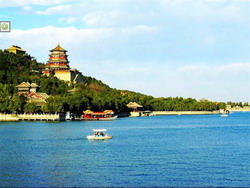
The Summer Palace is located on the western edge of Beijing, between the fourth and fifth ring roads, close to the western hills, 12km from central Beijing. It is not expensive to get there by taxi and does not take long. Use a map to tell the driver you want to be taken to the north gate if you want to follow our suggested route through the park, or ask your hotel receptionist to add 'north gate' to 'Summer Palace' written in chinese script on a piece of paper to show the taxi driver.
The Summer Palace in northwest suburban Beijing is the largest and most complete imperial garden existing in China. It was first built in the 12th century as an imperial palace. Renovation and extension in the following several hundred years till the end of the 19th century led it into the scale we see today, and was officially named Summer Palace.
Occupying an area of 304 hectares, the Summer Palace features hilly and water scenery. The Kunming Lake makes up four-fifths of this royal park.
As its name implies, the Summer Palace was used as a summer residence by China's imperial rulers - as a retreat from the main imperial palace now known as the Palace Museum (or 'Forbidden City') - a pleasureground in the countryside, yet near to the city.
The Summer Palace is virtually a museum of traditional Chinese gardening that uses rocks, plants, pavilions, ponds, cobble paths and other garden styles to create a poetic effect between different scenes. When you stroll around the Summer Palace, you will constantly find the area changing.
This Summer Palace guide looks at its history, presents a clear map with a suggested route through the palace grounds, and looks at each place of interest in detail. This guide contains 400 superb photographs that both illustrate each location, and hint at the beauty of the gardens as a whole.
The gardens that became the Summer Palace date from the Jin Dynasty (1115-1234).
Later, the Mongol Emperor Kublai Khan (Yuan Dynasty, 1279-1368), who wanted to improve Beijing's water supply, ordered the construction of canals to transport water from the Western Hills to the Summer Palace. He also enlarged the lake (now called KunMing Lake) to act as a reservoir.
In 1750, Emperor QianLong (1736-1796) of the Qing Dynasty (1644-1911) added substantially to the gardens of the Summer Palace. His appointed designers reproduced the styles of various palaces and gardens from around China. KunMing Lake was extended to imitate the West Lake in HangZhou.
In 1860, the Anglo-French Allied Forces invaded Beijing and set fire to many of the buildings within the Summer Palace.
In 1888, Dowager Empress CiXi, with embezzled funds from the Imperial Navy, restored the grand gardens. The reconstruction and enlargement of the Summer Palace continued for ten years. After completion, she renamed the gardens 'YiHeYuan' ('Garden of Peace and Harmony').
The Empress Dowager CiXi moved her administration to the renovated YiHeYuan in 1889 and the gardens that had long been an imperial pleasureground became the primary Summer Palace.
Tales of CiXi's excesses (including the Marble Boat, seen in the photo above) are numerous and came to symbolise the decadence of the imperial family.
The Summer Palace is sometimes referred to as the 'New Summer Palace'. The original primary Summer Palace (YuanMingYuan, or 'Old Summer Palace') was demolished in 1860 by invading Anglo-French forces. Then, shortly after, the eight allied powers invaded in 1900 during the Boxer Rebellion to plunder and destroy the newly reconstructed New Summer Palace.
Only when the fugitive CiXi returned to Beijing in 1903, did full-scale restoration begin. In this way, the Summer Palaces - old and new - are also associated in popular culture with the destructive interference of foreign powers.
Today's Summer Palace is more or less the same as the palace rebuilt from 1903.
After the success of the 1911 Revolution, the Summer Palace was opened to the public. Then, after the last Qing Emperor PuYi was thrown out of the Palaces in 1924, the Summer Palace was turned into a park. The Summer Palace has become a popular and relaxing destination for both domestic and international tourists.
The halls, pavilions, bridges and temples, Kunming Lake and Longevity Hill, all blend together harmoniously in spite of their individual styles. Ingeniously conceived an
|